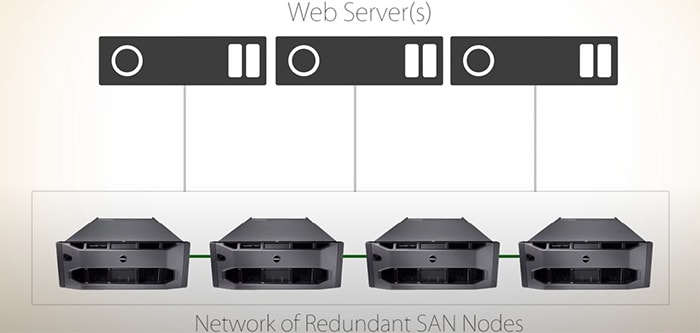What is SAN (Storage Area Network)?
SAN (storage area network) is a high-performance, high-speed network of storage, servers, and devices that allows access to consolidated, block-level storage. Multiple client devices can access it, and it usually appears to the client OS as a disk. SAN storage separates the storage system from the rest of the local area network (LAN). This way, they improve application performance, data protection, and disaster recovery if needed.
What Does SAN Storage Consist Of?
As already mentioned, storage area networks are usually physically separated from the rest of the LAN and can span multiple sites. They’re composed of SAN switches, hosts, and storage devices that are connected internally through a variety of SAN technologies.
What are the Advantages of SAN?
The five advantages of system area networks are:
- Scalability: SAN storage can be scaled easily to suit evolving business needs. Should you need more storage, more capacity can be added when and as it is required. That way, you will never have more storage than you need.
- Backup: Data backup should always be a major consideration, and if using SAN, you only need a single backup server for data that is potentially scattered across multiple locations.
- Reduces LAN Bandwidth Issues: LAN-based storage systems can be subject to bandwidth bottlenecks due to the fact that a large chunk of the network traffic is caused by data transfers. Since SAN takes that part of traffic onto itself, the performance of the entire LAN would improve and decrease the time needed for other tasks.
- Data Security: Using a SAN, data protection algorithms are consistent. Whenever you need it, you have access to accurate copies of any data on it. Additionally, should the LAN become compromised, your data would be secure since it is stored on a separate network.
- Disaster Recovery: Centralized data can be easily copied to a separate recovery device that’s ideally stored at a separate location as well. As such, if and when needed, the data can also be easily recovered, should anything disastrous happen.
What are the Disadvantages of SAN?
Here are three common disadvantages of using SAN:
- Complexity: A SAN can add additional layers of complexity to existing systems, increasing workload management.
- Cost: Implementing and managing a SAN can be cost-prohibitive for first-time users.
- Management: A SAN may be challenging to manage and may require a dedicated specialist to administer it.
The Most Common SAN Protocols
Here are three of the most common SAN protocols used:
- Fibre Channel Protocol (FCP): This is the most widely used SAN or block protocol. It is deployed in the majority of the SAN market. FCP uses Fibre Channel transport protocols embedded with SCSI commands.
- Internet Small Computer System Interface (iSCSI): iSCSI incorporates SCSI commands inside an Ethernet frame. For data transport, it uses an IP Ethernet network.
- Fibre Channel over Ethernet (FCoE): It is similar to iSCSI since it incorporates an FC frame inside an Ethernet datagram. It also uses an IP Ethernet network for transport.

How Does SAN Work?
SAN provides a high-speed infrastructure connecting servers to their logical disk units. A logical disk unit is an array of blocks allocated from a pool of storage units that are presented to the server as a logical disk.
Therefore, when connecting to a SAN from a LAN or a server, the SAN actually appears like a local disk. It does that in a way that any client device can store data on the logical unit, as it would on any local type of storage device.
A well-designed and distributed SAN can withstand multiple device or component failures, keeping the data safe.
Use Cases for SAN
SAN has its own local file system that enables the servers to partition and format the blocks to use as the local storage units they appear as. Storage area networks are used as support for performance-sensitive applications such as:
- Oracle Databases: These are often business-critical, and require the highest performance and availability.
- Microsoft SQL Server Databases: MS SQL Server databases also usually store an enterprise’s most valuable data. Therefore, they also require the highest performance and availability.
- Virtualization Deployments using KVM, Microsoft Hyper-V, or VMware: These environments can extend to thousands of virtual machines running a wide range of operating systems and applications, sometimes with varying performance requirements. These environments support many applications, so infrastructure reliability becomes even more important because a failure can cause multiple application outages.
- Large Virtual Desktop Infrastructures (VDIs): These environments serve virtual desktops to sometimes large numbers of an organization’s users. Some of them number tens of thousands of virtual desktops. By centralizing them, organizations can more easily manage data security.
- SAP, Large ERP, or CRM Environments: SAN architectures can be a perfect fit for different resource planning and other resource management workloads.
Regarding the hardware, HDDs are being replaced or combined with SSDs, thus creating hybrid arrays, as well as all-flash SANs.
So then, what are the key differences between San vs NAS (network-attached storage)?
What is Network-Attached Storage (NAS)?
Network-attached storage (NAS) is a network-based storage solution. NAS storage is a method of managing storage centrally and sharing that storage with multiple servers.
Unlike SAN, which uses Ethernet and FC, NAS uses Ethernet. Additionally, NAS focuses on ease of use, lower cost of ownership, and manageability.
Another difference between the two is that NAS storage controllers partition the storage. This makes a NAS server look like any other file server to the client-server connected to it. While SAN stores data at the block level, NAS accesses it as files. Therefore, it’s usually associated with unstructured data, such as images or video content, while SAN usually handles structured workloads like databases.
Hybrid and all-flash NAS hardware is also available due to the impact flash storage has had on storage mediums.
What are the Advantages of NAS?
Here are five advantages of using NAS:
- Architecture: NAS data lives in volumes of files and folders instead of blocks in a typical client-server architecture.
- Security: NAS provides security via user access controls and redundant data structures.
- Efficiency: NAS allows for an easy, quick, and low-cost method for data storage.
- Inexpensive: NAS is less expensive to purchase and maintain, although the cost of a high-end NAS will cost more than an entry-level SAN.
- Stability: Utilizing NAS removes individual servers as single points of failure.
What are the Disadvantages of NAS?
There are a few disadvantages to consider when choosing NAS:
- Single Point of Failure: Because NAS is considered a local on-site backup drive, failures can occur, leading to data loss.
- Speed: Heavy use of a NAS system can cause significant network congestion and lower transfer speed.
- Scalability: NAS devices are not easily scalable due to the limitations of the hardware.
- Quotas: System admins must enforce user quotas to prevent overutilization of shared space.
- Management: Basic networking knowledge is required to implement a NAS.
- Functionality: Capabilities will vary depending on manufacturer, chip, and size. Typically, NAS is only used for storage.
The Most Common NAS Protocols:
Here are the two most commonly used NAS protocols:
- Common Internet File Services/Server Message Block (CIFS/SMB): This is the protocol that Windows usually uses.
- Network File System (NFS): NFS was first developed for use with UNIX servers and is also a common Linux protocol.
SAN vs NAS: An Overview
Utilize the chart below to easily compare SAN vs NAS:
| SAN (Storage Area Network) | NAS (Network Attached Storage) |
|---|---|
| Usually More Expensive | Less Expensive |
| High-Speed Connections Using the Fibre Channel | Speed is Dependent on the Local Ethernet Network |
| Typically Used in Enterprise and Professional Environments | Typically Used in Homes or Small to Medium-Sized Businesses (SMBs) |
| Requires More Administration | Easier to Manage |
| Easily Scalable | Usually Not Highly Scalable |
| Requires Architectural Changes | No Architectural Changes Required |
| Redundant Functionalities and Fault-Tolerant Network | Often Has Single Points of Failure |
| Not Affected by Network Traffic Bottlenecks | Susceptible to Network Bottlenecks |
NAS or SAN: How Do You Choose?
Typically, SMBs would be better served to utilize a NAS device, whereas larger entities with the resources to invest in the architecture and management would profit from employing a SAN.
Here is a checklist of items for consideration when reviewing the need for storage options:
- Architecture needs.
- Data processing models.
- Network protocols and capabilities.
- Performance constraints.
- Scalability requirements.
- Management assets.
- Backup challenges.
- Redundancy imperatives.
- Disaster recovery dictates.
- Storage virtualization options.
- Price (TCO).
Evaluating these parameters prior to investing in a storage system will provide a clearer picture when defining the needs of an organization.
Choosing Flexible Storage
Whether you're storing databases or other types of data, a flexible storage space like SAN storage is always a good idea. Network storage is cost-effective, remote, and secured, making it a perfect choice for our increasingly remote workforce of today.
Check Out Liquid Web SAN Storage Today For High-Performance Block-Level Storage For Your Growing Infrastructure

Amy Myers
Amy is a Linux support technician with Liquid Web and Nexcess, with expertise in customer service. She considers expanding upon and sharing knowledge as one of life's top priorities. She is an avid technology and art fan.
Keep up to date with the latest Hosting news.




